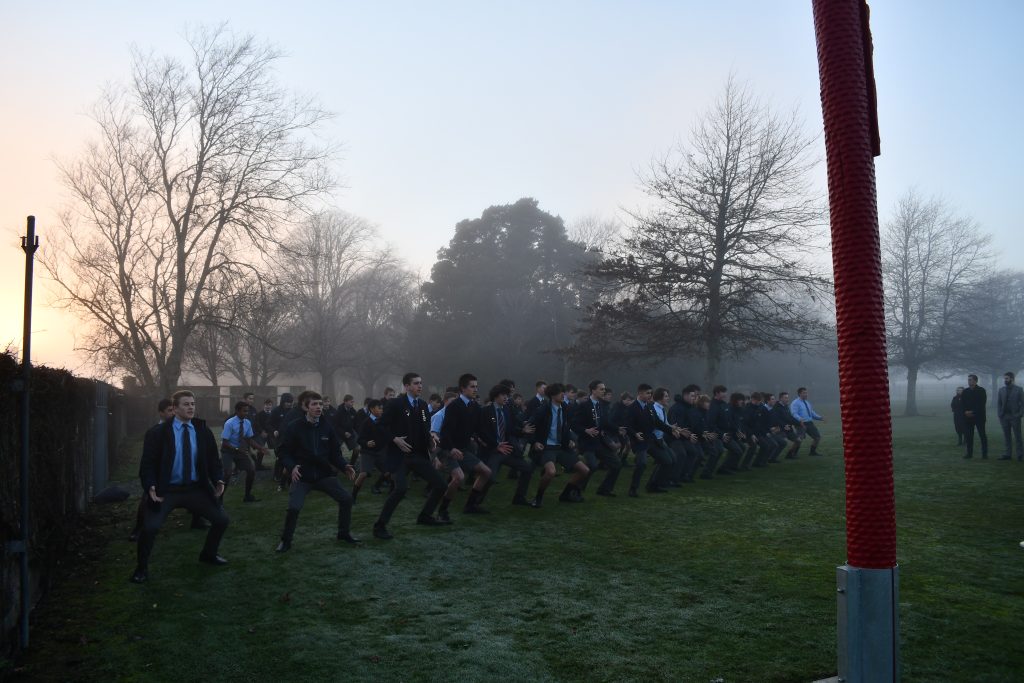The Story of Mātairangi

In July 2021, Mātairangi, our pou whenua, became an important part of HIBS. Encapsulating the life essence of our kura and acting as a guardian over us, Mātairangi was unveiled at the beginning of Matariki to recognise Te Tau Hou Māori, the Māori New Year. Mātairangi sits near our hāngī pit behind the tennis courts and looks out over our kura protecting us, while also facing the horizon, acknowledging the cluster of Matariki that is visible in late June or early July. Mātairangi is the name that was given to this pou upon its unveiling in 2021. However, there is a wider whakapapa to Mātairangi and the journey this pou took to be with us at HIBS.
Whātaitai is the original name of our pou we now know as Mātairangi. Whātaitai was once one of seven pou carved to identify sites of significance for our mana whenua, Te Āti Awa ki Te Whanganui-a-Tara. Due to the wild weather of Te Whanganui-a-Tara, the original seven pou were taken down over 10 years ago and replaced with new ones. The original pou were stored under the protection of the Wellington Tenths Trust. Over the last 10 years, these seven pou have been gifted to different rōpū and kura, with Whātaitai being the last. However, none of the pou that were gifted had a face like Whātaitai. Unfortunately, during its time in storage, the face had somehow become misplaced.
When the pou was offered to HIBS, parent and General Manager of the Wellington Tenths Trust, Vicki Hollywell, was keen to ensure it was gifted in its full original piece. Looking everywhere, she was unable to find the face. Then, on a classic windy southerly day in Te Whanganui-a-Tara, Vicki arrived at her mahi to find a container door wide open. As she walked over to the door and opened the container, there in front of her, was the face of Whātaitai. It was in a damaged state much like the pou. The face and pou were carefully delivered to HIBS and with the perseverance, care and crafty skills of our caretaker, it now has a new life.
The new name given to this pou upon its unveiling at HIBS in 2021 was ‘Mātairangi’. In Te Ao Māori, names are given after much consideration and consultation with elders and respected members of the iwi. The naming of this pou was no exception. The whānau at Wellington Tenths Trust considered the original name, considered what the piece looks like, what its purpose is and how they came to have it, including the events that occurred before, during and after it arrived to its eventual resting place at HIBS.

The name ‘Mātairangi’ is the mountain that we all know today as Mount Victoria. Mātairangi currently looks down over the resting place of Whātaitai, the taniwha who died while trying to break free from the lake now known as Te Whanganui-a-Tara harbour (Wellington Harbour). So, it is appropriate that these connections are seen here in this pou. When broken down into two words, Mātai means ‘to look over or to gaze at’. ‘Rangi’ refers to the sky. The name broken down therefore refers to ‘eyes in the sky looking over us all’. Not only the eyes of the Mātairangi, but all of those that have departed us in the past too.
The face of Mātairangi depicts the taniwha Whātaitai adorned with three raukura or albatross feathers symbolising the peaceful teachings of the prophets Te Whiti-o-Rongomai and Tohu Kākahi, who lived at the Taranaki village of Parihaka. When you have the time or are passing by the hāngī pit behind the tennis courts, take the time to greet Mātairangi and admire its beauty. Mātairangi is a guardian watching over our kura and is crucial to our tūrangawaewae and the whakapapa of HIBS.